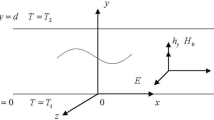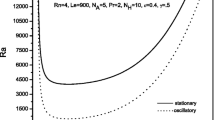Abstract
The current paper utilizes the viscous potential theory to analyze the temporal stability of a swirling annulus of two nano gas–liquid layers. The analysis depends mainly on the normal mode technique. The distributions of the heat, volume fraction, and velocity field are achieved. Furthermore, surface tension is considered as a function of the heat and the volume fraction distributions. Therefore, the impact of the Marangoni convection is taken into account. The balance of the normal stress tensor at the interface yields a complicated transcendental dispersion equation. Actually, this equation has no exact solution. Consequently, numerical calculations are established to indicate the relation between the growth rate and the wavenumber of the surface waves. Graphically, the influences of the various physical parameters are depicted. It is found that the Brownian motion accelerates the particles which leads to a destabilization of the interface. Simultaneously, the thermophoresis produces a motion of hot particles from the interface towards the boundaries, which stabilizes the interface. Furthermore, the increase of the surface tension, due to the Marangoni effect, enhances the interface rigidity and stabilizes it.












Similar content being viewed by others
Abbreviations
- \( \hat{C_{\ell }}, \hat{C_{g}} \) :
-
Nano-particles concentration, volume fraction, in liquid and gas
- \( C_{0} \) :
-
Basic nano-particles concentration
- \( C_{\ell } \) :
-
Nano-particles concentration in the liquid
- \( C_{g} \) :
-
Nano-particles concentration in the gas
- \( C_{w} \) :
-
Nano-particles concentration at the wall
- \( c_{p\,} \) :
-
Specific heat
- \( D_{T} \) :
-
Thermophoresis parameter
- \( D_{B} \) :
-
Brownian diffusion
- \( F \) :
-
Interface position function
- \( I_{0} \) :
-
Modified Bessel’s function of the first kind
- \( K_{0} \) :
-
Modified Bessel’s function of the second kind
- \( k \) :
-
Wavenumber
- \( k_{f} \) :
-
Thermal diffusivity
- \( Le \) :
-
Lewis parameter
- \( Na \) :
-
Modified diffusivity ratio
- \( p \) :
-
Pressure
- \( \Pr \) :
-
Prandtl number
- \( R \) :
-
Thickness of undisturbed liquid layer
- \( r \) :
-
Radial coordinate
- \( \text{Re} \) :
-
Reynolds number
- \( Ro \) :
-
Rossby number
- t :
-
Time
- \( T \) :
-
Perturbed temperature
- \( T_{0} \) :
-
Basic temperature
- \( \hat{T}_{\ell }, \hat{T}_g \) :
-
Temperature of the liquid and gas
- \( T_{\ell}, T_{g} \) :
-
Perturbed Temperature of the liquid and gas
- \( T_{w} \) :
-
Temperature at the wall
- \( u_{\ell } ,\,u_{g} \) :
-
Perturbed velocities of liquid and gas in the axial direction
- \( \hat{u}_{\ell } ,\,\hat{u}_{g} \) :
-
Velocities of liquid and gas in the axial direction
- \( U_{\ell } ,\,U_{g} \) :
-
Initial velocities of liquid and gas
- \( v_{\ell } ,\,v_{g} \) :
-
Perturbed velocities of liquid and gas in the radial direction
- \( \hat{v}_{\ell } ,\,\hat{v}_{g} \) :
-
Velocities of liquid and gas in the radial direction
- \( w_{\ell } ,\,w_{g} \) :
-
Perturbed velocities of liquid and gas in the azimuthal direction
- \( \hat{w}_{\ell } ,\,\hat{w}_{g} \) :
-
Velocities of liquid and gas in the azimuthal direction
- \( \rho \) :
-
Density of the fluid
- \( \theta \) :
-
Azimuthal coordinate
- \( \beta \) :
-
Initial angular velocity
- \( \sigma \) :
-
Surface tension
- \( \omega ,\,\varOmega \) :
-
Wave frequency
- \( \alpha_{f} \) :
-
Non-dimensional thermal diffusivity
- \( \eta \) :
-
Disturbance of the interface
- \( (\rho c_{p} )_{f} \) :
-
Heat capacities of the fluid
- \( (\rho c_{p} )_{p} \) :
-
Heat capacities of the nanoparticles
- \( g \) :
-
Quantities of the gas phase
- \( \ell \) :
-
Quantities of the liquid phase
- \( C \) :
-
Solutal quantity
- \( T \) :
-
Thermal quantity
- \( j \) :
-
Suffix denoted for liquid (\( \ell \)) or gas (\( g \))
References
Akbari M, Galanis N, Behzadmehr A (2011) Comparative analysis of single and two-phase models for CFD studies of nanofluid heat transfer. Int J Ther Sci 50:1343–1354
Andrade EN, Da C (1963) Whirlpools, vortices and bath tubs. New Sci 17(325):302–304
Asthana R, Agrawal GS (2007) Viscous potential flow analysis of Kelvin-Helmholtz instability with mass transfer and vaporization. Phys A 382:389–404
Asthana R, Agrawal GS (2010) Viscous potential flow analysis of electrohydrodynamic Kelvin–Helmholtz instability with heat and mass transfer. Int J Eng Sci 48:1925–1936
Bazarov V, Yang V, Puri P, (2004) Design and dynamics of jet and swirl injectors. In: Progress in astronautics and aeronautics, vol 200, chap 2. AIAA, pp 19–103
Buongiorno J (2006) Convective transport in nanofluids. J Heat Transf 128:240–250
Chandrasekhar S (1961) Hydrodynamic and hydrodynamic stability. Oxford University Press, Oxford
Chen CH (2007) Marangoni effects on forced convection of power-law liquids in a thin film over a stretching surface. Phys Lett A 370:51–57
Feynman R (1964) The Brownian Movement Feynman Lec. Phys. http://feynmanlectures.caltech.edu/I_41.html. Accessed 30 Oct 2019
Fu Q, Yang L (2011) Theoretical Investigation of the dynamics of a gas-liquid coaxial swirl injector. J Propuls Power 27(1):144
Fu Q, Yang L, Tong M (2014) Absolute and convective instability of a confined swirling annular liquid layer. Atomization Sprays 24(7):555–573
Fu QF, Jia BQ, Yang LJ (2017) Stability of a confined swirling annular liquid layer with heat and mass transfer. Int J Heat Mass Transf 104:644–649
Fu QF, Deng XD, Jia BQ, Yang LJ (2018) Temporal instability of a confined liquid film with heat and mass transfer. AIAA J 56:1–8
Funada T, Joseph DD (2001) Viscous potential flow analysis of Kelvin–Helmholtz instability in a channel. J Fluid Mech 445:263–283
Funada T, Joseph DD (2002) Viscous potential flow analysis of capillary instability. Int J Multiph Flow 28:1459–1478
Funada T, Joseph DD (2003) Viscoelastic potential flow analysis of capillary instability. J Non-Newton Fluid Mech 111:87–105
Gomez L, Mohan R, Shoham O (2004a) Swirling gas–liquid two-phase flow—experiment and modeling part I: swirling flow field. Trans ASME J Fluids Eng 126:935–942
Gomez L, Mohan R, Shoham O (2004b) Swirling gas–liquid two-phase flow—experiment and modeling part II: turbulent quantities and core stability. Trans ASME J Fluids Eng 126:943–959
Hassan MA (2018) Thermosolutal Marangoni convection effect on the MHD flow over an unsteady stretching sheet. J Egypt Math Soc 26(1):57–70
Hassan MA (2019) Linear instability of viscoelastic nanofluid microjet with the effect of Marangoni convection. Phys Scr 94:025701
Hsieh DY (1972) Effects of heat and mass transfer on Rayleigh–Taylor instability. J Basic Eng 94:156–159
Hsieh DY (1978) Interfacial stability with mass and heat transfer. Phys Fluids 21:745–748
Jia BQ, Yang LY, Xie L, Fu QF, Cui X (2019) Linear stability of confined swirling annular liquid layers in the presence of gas velocity oscillations with heat and mass transfer. Int J f Heat Mass Transf 138:117–125
Kannaiyan K, Sadr R (2017) The effects of alumina nanoparticles as fuel additives on the spray characteristics of gas-to-liquid jet fuels. Exp Therm Fluid Sci 87:93–103
Magyari E, Chamkha AJ (2008) Exact analytical results for the thermosolutal MHD Marangoni boundary layers. Int J Therm Sci 47:848–857
Moatimid GM, Hassan MA (2012) Viscous potential flow of electrohydrodynamic Kelvin-Helmholtz instability through two porous layers with suction/injection effect. Int J Eng Sci 54:15–26
Moatimid GM, Hassan MA (2013) The instability of an electrohydrodynamic viscous liquid micro-cylinder buried in a porous medium: effect of thermosolutal Marangoni convection. Math Probl Eng 2013:416562
Moatimid GM, Hassan MA (2014) Three-dimensional viscous potential electrohydrodynamic Kelvin–Helmholtz instability through vertical cylindrical porous inclusions with permeable boundaries. J Fluids Eng 136(021203):1–10
Moatimid GM, Hassan MA (2018) Linear instability of water-oil electrohydrodynamic nanofluid layers: analytical and numerical study. J Comput Theor Nanosci 15:1495–1510
Moatimid GM, Obied Allah MH, Hassan MA (2013) Kelvin–Helmholtz instability for flow in porous media under the influence of oblique magnetic fields: a viscous potential flow analysis. Phys Plasmas 20:102111
Probstein RF (1994) Physicochemical Hydrodynamics: An Introduction, 2nd edn. Wiley, Hoboken
Selvan VAM, Anand RB, Udayakumar M (2014) Effect of cerium oxide nanoparticles and carbon nanotubes as fuel-borne additives in diesterol blends on the performance, combustion and emission characteristics of a variable compression ratio engine. Fuel 130:160–167
Sheikholeslami M (2018) Finite element method for PCM solidification in existence of CuO nanoparticles. J Mol Liq 265:347–355
Sheikholeslami M (2019a) New computational approach for exergy and entropy analysis of nanofluid under the impact of Lorentz force through a porous media. Comput Methods Appl Mech Eng 344:319–333
Sheikholeslami M (2019b) Numerical approach for MHD Al2O3-water nanofluid transportation inside a permeable medium using innovative computer method. Comput Methods Appl Mech Eng 344:306–318
Sheikholeslami M, Chamkha AJ (2017) Influence of Lorentz forces on nanofluid forced convection considering Marangoni convection. J Mol Liq 225:750–757
Sheikholeslami M, Rezaeianjouybari B, Darzi M, Shafee A, Li Z, Nguyen TK (2019) Application of nano-refrigerant for boiling heat transfer enhancement employing an experimental study. Int J Heat Mass Transf 141:974–980
Sheu LJ (2011) Linear stability of convection in a viscoelastic nanofluid layer. World Acad Sci Eng Technol 58:289–295
Sinan G, Kunt A, Hakan E (2014) Comparison of single and two-phase models for nanofluid convection at the entrance of a uniformly heated tube. Int J Ther Sci 80:83–92
Soutter W (2019) Nanoparticles as fuel additives. https://www.azonano.com/article.aspx?ArticleID=3085. Accessed 25 Jan 2020
Web site: Engineeringtoolbox (2009) https://www.engineeringtoolbox.com/prandtl-number-d_1068.html. Accessed 25 Jan 2020
Web site: Wikipedia (2014) https://en.wikipedia.org/wiki/Prandtl_number. Accessed 25 Jan 2020
Yan K, Ning Z, Lü M, Sun C, Fu J, Li Y (2015) Interface instability mechanism of an annular viscous liquid sheet exposed to axially moving inner and outer gas. Eur J Mech B/Fluids 52:185–190
Author information
Authors and Affiliations
Corresponding author
Additional information
Publisher's Note
Springer Nature remains neutral with regard to jurisdictional claims in published maps and institutional affiliations.
Appendix
Appendix
The constants that appearing in Eq. (25) may be listed as follows:
where \( \text{Re}_{j} = \frac{{\rho_{j} U_{j} R}}{{\mu_{j} }},\, \) are Reynold’s numbers for liquid and gas phases, and
\( \Pr_{j} = \frac{{(c_{p\,} \mu )_{j} }}{{k_{{f_{j} }} }},\, \) are Prandtl numbers for liquid and gas phases.
\( Le_{j} = \frac{{k_{{f_{j} }} }}{{(\rho c_{p} )_{j} D_{{B_{j} }} }} \), are Lewis numbers for liquid and gas phases, respectively.
The constants of solutions (28)-(30) are derived by using the boundary conditions (27) as follows:
where
Rights and permissions
About this article
Cite this article
Moatimid, G.M., Hassan, M.A. & Mohamed, M.A.A. Temporal instability of a confined nano-liquid film with the Marangoni convection effect: viscous potential theory. Microsyst Technol 26, 2123–2136 (2020). https://doi.org/10.1007/s00542-020-04772-2
Received:
Accepted:
Published:
Issue Date:
DOI: https://doi.org/10.1007/s00542-020-04772-2




